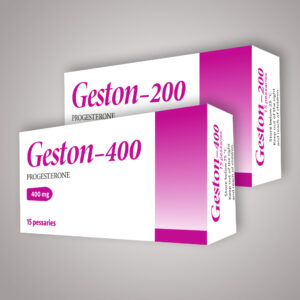
GESTERON 200 mg vaginal suppositories
GESTERON
International non-patented name: Progesterone
Composition
Active substance: 1 suppository contains 200 mg of progesterone
Auxiliary substances: polyethylene glycol 400, polyethylene glycol 6000, white beeswax
Description
They are white, oval-shaped suppositories.
Pharmacotherapeutic group
Sex hormones and modulators of the reproductive system. Progestagen.
ATC : G03DA04.
Pharmacological
Progesterone, the active substance of Gesteron preparation, is identical to the natural corpus luteum hormone of the ovary. It binds to receptors on the surface of target-organ cells and enters the nucleus, activates DNA and stimulates the synthesis of RNA. It facilitates the transition of the mucous membrane of the uterus from the proliferation phase provided by the follicular hormone to the secretory phase, and after fertilization to the state necessary for the development of the fertilized egg cell. It weakens the alertness and contractility of the muscle layer of the uterus and fallopian tubes. It activates the development of the secretory parts of the acini in the mammary gland and induces lactation.
It stimulates protein lipase, increases fat reserves, increases the consumption of glucose by increasing the concentration of basal and stimulated insulin, creates conditions for the accumulation of glycogen in the liver, increases the production of gonadotropic hormones of the pituitary gland, reduces azotemia, and increases nitrogen excretion with urine.
Pharmacokinetics
During intravaginal injection
Absorption is rapid, the high level of progesterone in the blood plasma is reached 1 hour after vaginal use. The Cmax level of progesterone in the blood plasma is reached 3-8 hours after injection. When the drug is used once a day in a dose of 200 mg, the average concentration is maintained at the level of 9.7 ng/ml for 24 hours. When using doses higher than 200 mg/day, the concentration of progesterone corresponds to the first trimester of pregnancy. Binding with plasma proteins – 90%. Progesterone accumulates in the uterus.
Metabolism
It is metabolized mainly to form 3-alpha, 5-beta-pregnanediol. Plasma levels of 5-beta-pregnanolone do not increase.
Exclusion
It is excreted in urine in the form of metabolites, the main part of metabolites is 3-alpha, 5-beta-pregnanediol (pregnandione). This is confirmed by the constant increase in its concentration (Cmax is 142 ng/ml after 6 hours).
Instructions for use
- Progesterone deficiency conditions in women.
- Replacement hormone therapy in cases of progesterone deficiency during ovarian inactivity (absence) (egg cell donation);
- Prevention (prophylaxis) of premature birth in women from the risk group (short cervical length);
- Support of the lutein phase during preparation for in vitro fertilization;
- Support of the lutein phase during the spontaneous or induced menstrual cycle;
- Infertility caused by lutein deficiency;
- Prevention of miscarriage and the risk of miscarriage caused by progesterone deficiency.
Contraindications
- Hypersensitivity to any of the components of the preparation.
- Undiagnosed vaginal bleeding.
- Bleeding of unknown etiology, thrombophilic or thromboembolic disorders, acute liver failure.
- Cerebral hemorrhage.
- Tendency to thrombosis, acute forms of thrombophlebitis or thromboembolic diseases, incomplete abortions, porphyria.
- Detected and probable malignant derivatives of mammary glands and genital organs.
Special instructions and precautions
Since progesterone is metabolized in the liver, it should be used with caution in patients with functional impairment of the liver. Since the amount of progesterone in women is high in the second half of the menstrual cycle and during pregnancy, in these cases, it is necessary to pay attention to sensitivity to the drug when prescribing Gestero to women. If there is a risk of developing breast cancer during the appointment of progesterone, in this case, the drug should be stopped. Progesterone should be prescribed with caution and under special control in cases of cardiovascular system diseases, liver failure, diabetes, asthma, epilepsy, migraine, chronic kidney failure, arterial hypertension, bronchial asthma, hyperlipoproteinemia, lactation period, mental depression. It is not appropriate to use the drug as a contraceptive. It is not considered suitable for use in children. The drug should not be taken with food.
Interaction with other drugs
- This medicine can interfere with the effects of bromocriptine and increase the plasma concentration of cyclosporine.
- It can affect the results of laboratory tests of liver and endocrine functions.
- The metabolism of the drug is accelerated by rifampicin and antibacterial substances.
- Ketoconazole can increase the bioavailability of progesterone by inhibiting its metabolism.
Use during pregnancy and lactation
- Gesterone is not used during pregnancy. The drug is not used to treat premature births.
- No association was found between the use of natural progesterone in early pregnancy and fetal malformations.
- It is not used during breastfeeding.
Effects on the ability to drive vehicles and other potentially dangerous mechanisms
As side effects such as drowsiness, dizziness, and visual disturbances may occur, it is necessary to take an individual approach to taking the drug.
Method of use and dosage
A single dose of 200 mg of Gesteron is injected daily into the uterus (vaginal route) or rectum (rectal route), but it is possible to increase the dose to 400 mg 2 times a day. Gesteron 400 mg single dose is used daily vaginally or rectally. The drug is usually used in the following manner:
At risk of miscarriage: Grade 1: 100-200 mg daily for 7 days, then continue with 50 mg daily for 20 days. Grade 2: 100-200 mg daily for 7 days, then continue with 100 mg daily for 20 days.
During normal miscarriage: it is necessary to start using Gesterone in a dose of 50-100 mg 2 or 3 times a week from the beginning of pregnancy. During the 3rd month of pregnancy, due to the involution of the corpus luteum, the administration of the drug requires special attention when the natural secretion of progesterone decreases.
Hypermenorrhea, polymenorrhea, metrorrhagia: hormone therapy should be started in advance in case of endometrial disorders. The use of Gesterone should be started a few days before menstruation and with a dose not less than 50 mg.
Amenorrhoea, hypomenorrhoea and oligomenorrhoea: progesterone alone or in combination with FSH (follicle-stimulating hormone) and LH (luteinizing hormone) should be used only after diagnosis (pituitary, uterus, ovary). Due to its relationship with estrogens, Gesteron should be prescribed in a dose of 25 mg 5 days a month in such cases.
Surgery during pregnancy: 100-200mg dose per day or according to doctor’s advice.
Premenstrual disorders: in some cases, daily treatment with a dose of 50 mg is recommended from the 14th day of the menstrual cycle.
The use of progesterone can be reduced against the background of symptom relief.
Side effects
Gastrointestinal pathologies, acne, fluid retention or edema, weight change, allergic skin itching or hives, mental disorder, breast discomfort or, rarely, gynecomastia and libido changes. Jaundice has been observed in very rare cases due to changes in liver function. Statistically significant cases of thrombophilia (peripheral, cranial, lung, kidney), as well as neuro-ocular symptoms were noted against the background of estrogen-related progesterone administration. Other side effects: hypertension in some individuals, premenstrual syndrome, changes in some test results against the background of changes in liver function (tests such as BSF, alkaline phosphatase, transaminases and hemagglutination), chloasma, alopecia, hirsutism.
Overdose
Overdose may cause dizziness, drowsiness, euphoria or dysmenorrhea.
Treatment: symptomatic and supportive treatment is carried out.
Packing form
Gesterone 200 mg.
5 suppositories, in a blister. 3 blisters are packed in a cardboard box with a leaflet.
Store condition
It should be stored at a temperature below 25°C and out of the reach of children.
Shelf life
3 years
By presciption.
Manufacturer
Kwality Pharmaceuticals LTD, India.
Village Nag Kalan, Majitha Road, Amritsar, Punjab, India.
